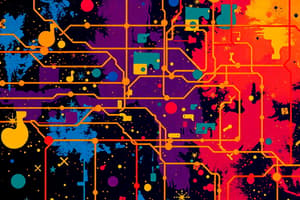Podcast
Questions and Answers
Which flag is used to indicate the urgency of data in a TCP segment?
Which flag is used to indicate the urgency of data in a TCP segment?
- RST
- PSH
- FIN
- URG (correct)
What is the purpose of the acknowledgment (ACK) flag in TCP?
What is the purpose of the acknowledgment (ACK) flag in TCP?
- To establish sequence numbers
- To indicate that a packet has been received (correct)
- To request immediate delivery of data
- To reset the connection
How does TCP ensure that packets arrive in the correct order?
How does TCP ensure that packets arrive in the correct order?
- By assigning sequence numbers to each segment (correct)
- By using random sequence numbers for each packet
- By prioritizing certain packets over others
- By discarding out-of-order packets
What feature of TCP helps to maintain data flow and prevent device overload?
What feature of TCP helps to maintain data flow and prevent device overload?
Which of the following is a characteristic of UDP as compared to TCP?
Which of the following is a characteristic of UDP as compared to TCP?
What occurs when TCP segments arrive out of order?
What occurs when TCP segments arrive out of order?
Why doesn’t the Initial Sequence Number (ISN) begin at one but rather at a random number?
Why doesn’t the Initial Sequence Number (ISN) begin at one but rather at a random number?
What is the purpose of the sequence (SEQ) number in TCP?
What is the purpose of the sequence (SEQ) number in TCP?
How does TCP acknowledge received segments?
How does TCP acknowledge received segments?
What does selective acknowledgment (SACK) allow in TCP?
What does selective acknowledgment (SACK) allow in TCP?
What is flow control in the context of TCP?
What is flow control in the context of TCP?
What role does the window size play in TCP?
What role does the window size play in TCP?
What problem can occur with expectational acknowledgment in traditional TCP?
What problem can occur with expectational acknowledgment in traditional TCP?
What happens if segments 3 and 4 are lost when host A sends segments 1 through 10?
What happens if segments 3 and 4 are lost when host A sends segments 1 through 10?
What is the main advantage of using selective acknowledgment over traditional acknowledgment in TCP?
What is the main advantage of using selective acknowledgment over traditional acknowledgment in TCP?
What does the acknowledgment number in TCP indicate?
What does the acknowledgment number in TCP indicate?
What is the purpose of conversation multiplexing in the transport layer?
What is the purpose of conversation multiplexing in the transport layer?
Which protocol primarily focuses on ensuring reliable message transfer between hosts?
Which protocol primarily focuses on ensuring reliable message transfer between hosts?
What is added to each block of data by the transport layer protocol to facilitate proper communication handling?
What is added to each block of data by the transport layer protocol to facilitate proper communication handling?
What role does error checking play in data transmission at the transport layer?
What role does error checking play in data transmission at the transport layer?
What is the function of a port number in the transport layer?
What is the function of a port number in the transport layer?
Which transport layer protocol is characterized by simplicity and speed but lacks reliability?
Which transport layer protocol is characterized by simplicity and speed but lacks reliability?
How does the transport layer ensure that all applications on a device receive the correct data?
How does the transport layer ensure that all applications on a device receive the correct data?
What is NOT a responsibility of the transport layer?
What is NOT a responsibility of the transport layer?
What can result from sending a type of data like a streaming video as one continuous communication stream?
What can result from sending a type of data like a streaming video as one continuous communication stream?
Flashcards
URG flag
URG flag
Indicates that the data in the segment has urgent information that needs immediate processing.
ACK flag
ACK flag
Used in TCP to acknowledge the receipt of a segment; essential for reliable communication.
PSH flag
PSH flag
Instructs the receiving TCP to push the received data immediately to the application layer.
RST flag
RST flag
Signup and view all the flashcards
SYN flag
SYN flag
Signup and view all the flashcards
FIN flag
FIN flag
Signup and view all the flashcards
Sequence number
Sequence number
Signup and view all the flashcards
TCP Segment Retransmission
TCP Segment Retransmission
Signup and view all the flashcards
SEQ Number
SEQ Number
Signup and view all the flashcards
ACK Number
ACK Number
Signup and view all the flashcards
Expectational Acknowledgement
Expectational Acknowledgement
Signup and view all the flashcards
Selective Acknowledgment (SACK)
Selective Acknowledgment (SACK)
Signup and view all the flashcards
TCP Flow Control
TCP Flow Control
Signup and view all the flashcards
Window Size
Window Size
Signup and view all the flashcards
Duplicate segments
Duplicate segments
Signup and view all the flashcards
Three-way handshake
Three-way handshake
Signup and view all the flashcards
Transport Layer Segmentation
Transport Layer Segmentation
Signup and view all the flashcards
Header Information
Header Information
Signup and view all the flashcards
Data Reassembly
Data Reassembly
Signup and view all the flashcards
Port Number
Port Number
Signup and view all the flashcards
Conversation Multiplexing
Conversation Multiplexing
Signup and view all the flashcards
Transport Layer Protocols
Transport Layer Protocols
Signup and view all the flashcards
IP Layer
IP Layer
Signup and view all the flashcards
Segment
Segment
Signup and view all the flashcards
Datagrams
Datagrams
Signup and view all the flashcards
Study Notes
Transport Layer
- Data is transported from one host to another at the transport layer.
- Two main protocols are used: TCP and UDP.
- TCP is like a registered letter—it requires a signature and confirmation of delivery, so it's slower but more reliable.
- UDP is like a regular, stamped letter—it's faster but doesn't guarantee delivery, and it's used for applications where speed is more important.
Role of the Transport Layer
- The transport layer facilitates communication between applications running on different hosts.
- It creates logical communication channels between applications.
- It handles tasks like session establishment and reliable data transmission.
- It's independent of the physical network and underlying media.
Tracking Individual Conversations
- Each conversation between applications is tracked separately by the transport layer
- The transport layer maintains multiple conversations concurrently.
Segmenting Data
- Data is divided into smaller, more manageable pieces called segments or datagrams.
- This is done to accommodate networks with limitations on packet size.
Transport Layer Header Information
- Header information is added to each data segment.
- This information contains binary data organized into fields that enable functions in managing data communication, like reassembling data blocks at the destination.
Identifying Applications
- The transport layer has the ability to identify and direct data to different applications
- This is accomplished through port numbers.
Conversation Multiplexing
- Transport layer handles the segmentation and multiplexing of diverse data streams.
- This allows numerous conversations to share the same network connection without interference.
TCP Protocol
- TCP is a connection-oriented protocol that establishes a connection before data transmission.
- It guarantees reliable delivery by checking for lost packets.
- TCP divides data into segments and ensures that they're delivered in the correct order.
- TCP provides sequence numbering to track segments and acknowledgements to confirm receipt.
- TCP employs flow control to manage data transmission speed to avoid overwhelming the receiving device.
UDP Protocol
- UDP is a connectionless protocol, meaning segments are sent without prior connection establishment.
- It ensures minimal delay and is suitable for applications that tolerate some data loss.
- UDP handles data in packets and does not acknowledge segment delivery.
- UDP is less complex than TCP.
TCP/IP
- Handles data reliability, delivery, and segment organization.
- TCP/IP does not specify how the transport of packets takes place but is responsible for how messages transfer between hosts.
- It specifies the reliability requirements of a conversation, for example, through TCP and UDP.
UDP
- Is a simpler, faster protocol than TCP for applications that can tolerate some loss in their data communication, like video streaming.
- Relies on the application layer to handle reliability if needed.
- Uses port numbers to distinguish between different applications, similar to TCP.
Studying That Suits You
Use AI to generate personalized quizzes and flashcards to suit your learning preferences.




